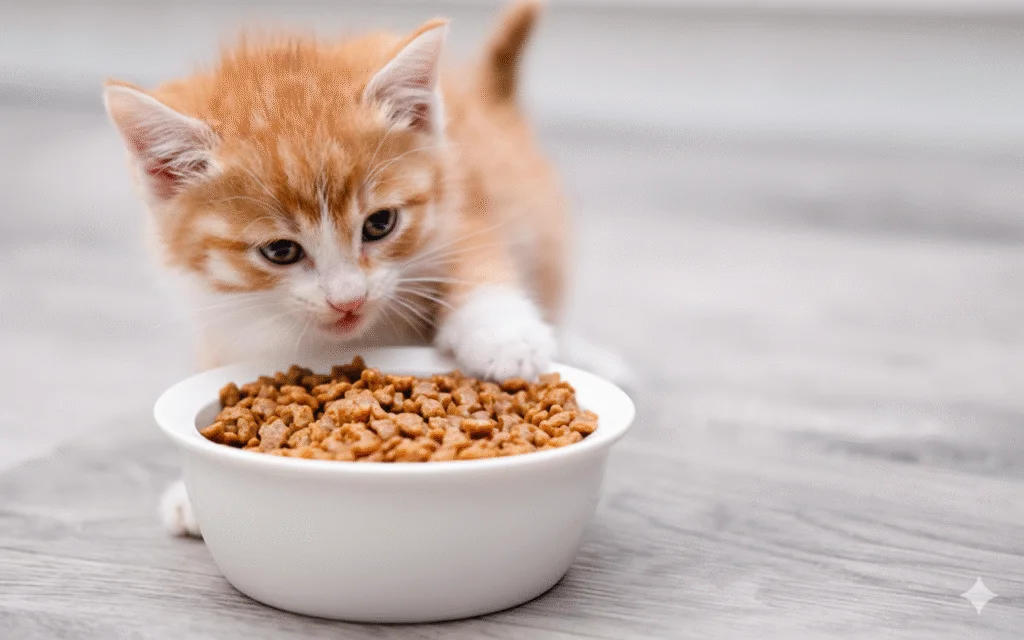Choosing food for a cat often feels more complicated than it should. Shelves are stacked with labels for kittens and adults, and the difference is not always clear. That is why many cat owners ask whether a kitten can eat food made for adult cats or if an adult cat can share a kitten’s meal. The answer is no. This article explains the key nutritional differences between kitten food vs adult cat food and why you should only give the right food to the cats.
In this article
The Key Differences: Kitten Food vs. Adult Cat Food
Here are some key differences between kitten food vs adult cat food:
A. Nutritional Content
Kittens have bodies that develop rapidly, so their diets are built to deliver more protein, fat, and calories. This concentrated energy fuels muscle growth, organ development, and strong bones. On the other hand, adult cats do not grow at the same pace. Their food is designed with fewer calories and carefully balanced nutrients to prevent weight gain and to maintain steady health over time.
B. Essential Nutrients
A kitten’s food is enriched with nutrients like DHA, which supports brain and vision development, and higher levels of calcium and phosphorus for bone strength. These nutrients are critical in the early stages of life, but can be excessive for older cats. Adult cat food instead focuses on maintaining lean muscle, protecting kidney function, and supporting long-term health. The nutritional focus shifts with age, which is why formulas are not interchangeable.
C. Kibble Size and Texture
The kibble for kittens is smaller and softer, so developing teeth can handle it easily. Adult kibble is larger and firmer to encourage chewing and keep teeth strong. Wet food follows the same approach, with smooth blends for kittens and thicker textures for mature cats.
The differences between kitten and adult cat food come from specialized production systems that balance proteins, fats, vitamins, and minerals with precision, while also shaping kibble to the right size and texture. High-quality, nutritionally precise cat food is made possible through processes such as accurate ingredient measurement, temperature control, and thorough mixing.
What Happens if You Feed Your Kitten Adult Cat Food?
Can kittens eat adult cat food? Now let’s have a look at what happens if you interchange the kitten food and adult cat food:
A. Nutritional Deficiencies
Kittens rely on food that contains high levels of protein, calcium, and DHA to grow properly. Adult cat food does not provide these nutrients in the amounts required. Over time, a kitten fed only adult food shows slower growth, weaker bones, and poor development of the brain and eyes.
B. Insufficient Energy
A kitten’s daily activity level and rapid body growth demand more calories than an adult cat’s. Feeding a kitten a lower-calorie diet often results in poor weight gain and reduced vitality.
C. Digestive Issues
Kittens have sensitive digestive systems that are not fully mature. Adult formulas can be heavier in fiber or contain protein blends that are harder to process. This mismatch often leads to soft stools, stomach upset, or inconsistent digestion.

What Happens if You Feed Your Adult Cat Kitten Food?
Can adult cats eat kitten food? The answer is again no. Here is why:
A. Weight Gain and Obesity
Kitten formulas are packed with extra calories and fat to support fast growth. An adult cat does not need this level of energy. Eating it regularly often leads to rapid weight gain, which increases the risk of diabetes, arthritis, and reduced mobility.
B. Risk of Pancreatitis
The higher fat levels in kitten formulas can overload an adult cat’s pancreas. This strain may lead to pancreatitis, an inflammation that causes pain and long-term health problems if not treated promptly.
C. Dietary Imbalance
In kittens’ food, nutrients such as calcium and phosphorus are included in higher amounts for growing bones. An adult cat does not benefit from these excesses. Instead, they create an imbalance that puts stress on their kidneys and other organs.
How and When to Switch Your Cat’s Food
Kittens usually need to stay on their growth formula until they are about twelve months old. Larger breeds may benefit from waiting until around eighteen months before moving to adult food. This timing allows their bodies to finish the most important growth stages without missing out on the extra calories and nutrients designed for young cats.
So, when to switch from kitten to cat food? Switching foods should be gradual to avoid stomach upset. Here is a simple approach:
- Start with a mix of seventy-five percent kitten food and twenty-five percent adult food for the first three to four days.
- Move to a fifty-fifty mix for the next three to four days.
- Shift to twenty-five percent kitten food and seventy-five percent adult food for another three to four days.
- Finish the change with one hundred percent adult food.
This steady transition helps your cat’s digestive system adjust while keeping mealtimes stress-free.

FAMSUN Pet Food Solutions
Producing food that meets the exact needs of kittens and adult cats requires technology that can maintain quality at every stage. FAMSUN develops equipment that allows manufacturers to create precise formulas for pets worldwide. Each year, more than 200 companies use FAMSUN systems to produce over four million tons of high-grade pet food.
The company’s technology is designed to control every part of production, from blending proteins and fats to shaping kibble for the right size and texture. These machines support consistent quality, stable nutrition, and safe handling of raw materials.
FAMSUN also provides full service after installation. Support teams help producers fine-tune equipment, keep lines efficient, and resolve technical issues quickly.











